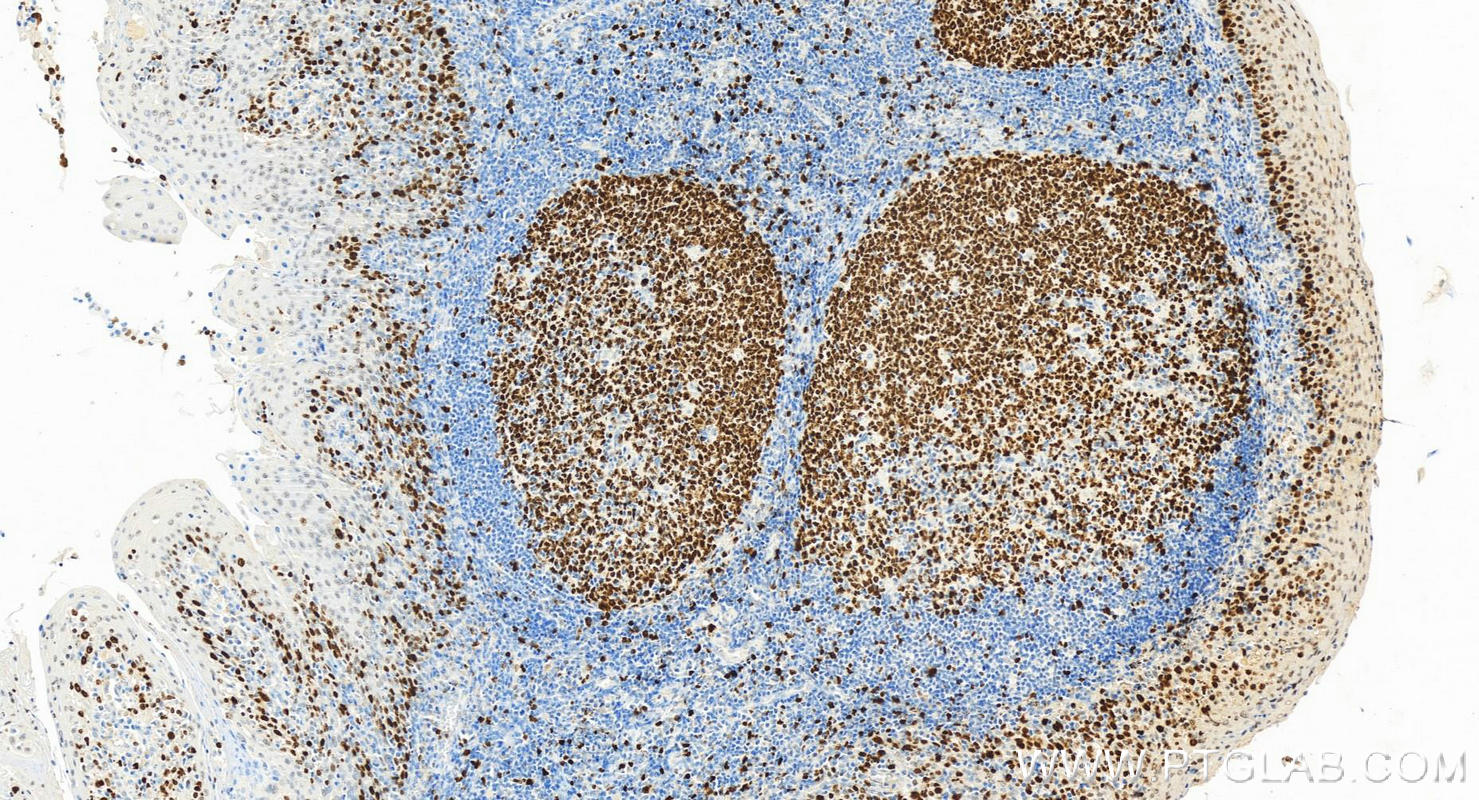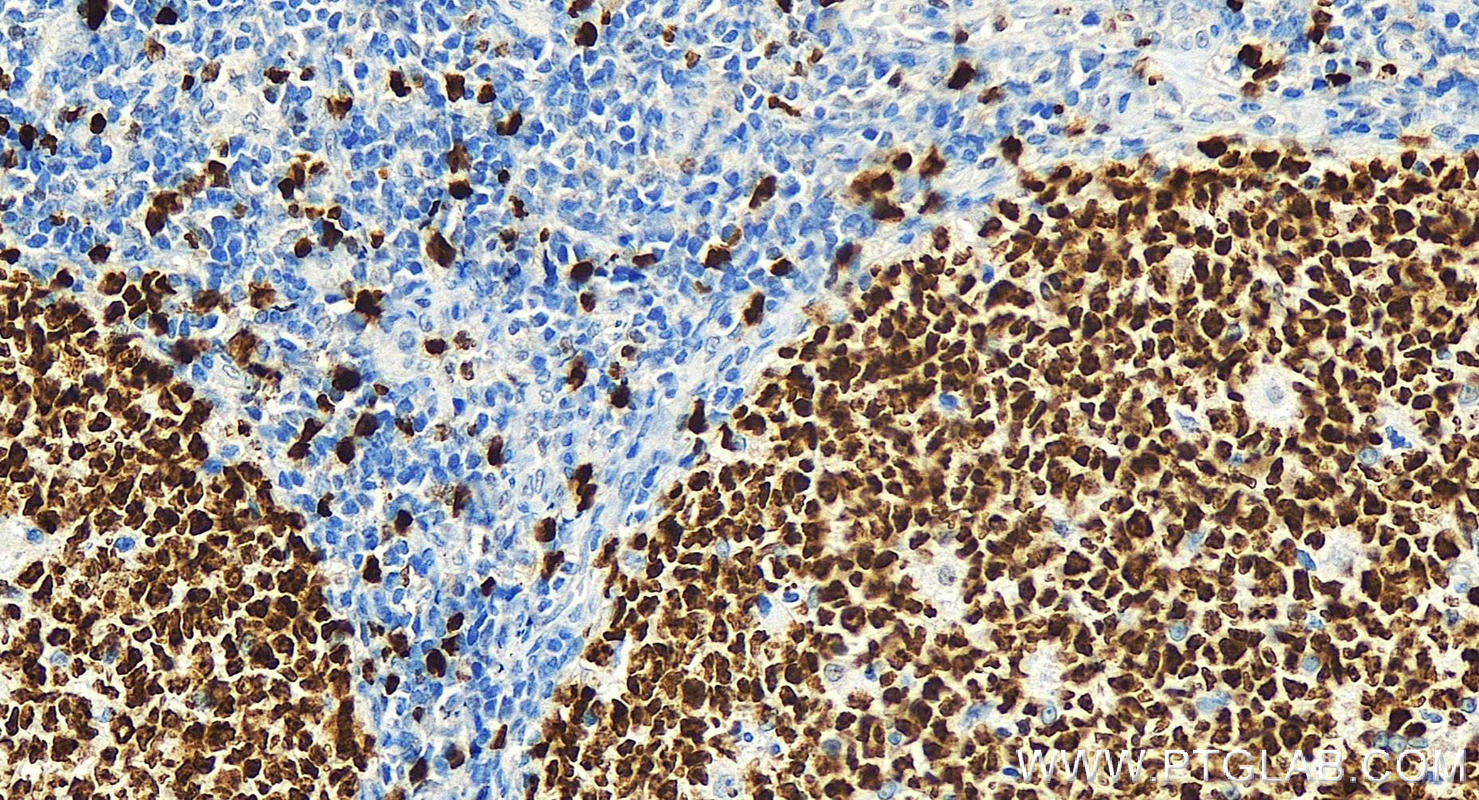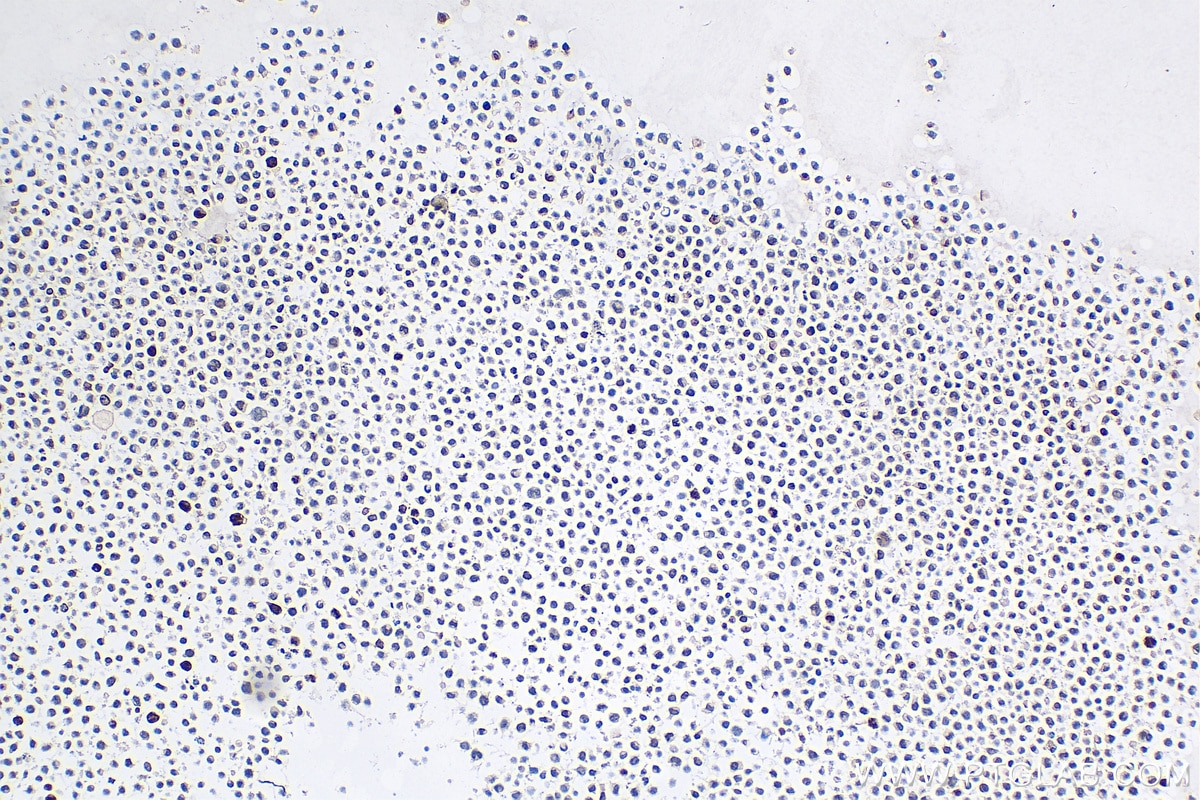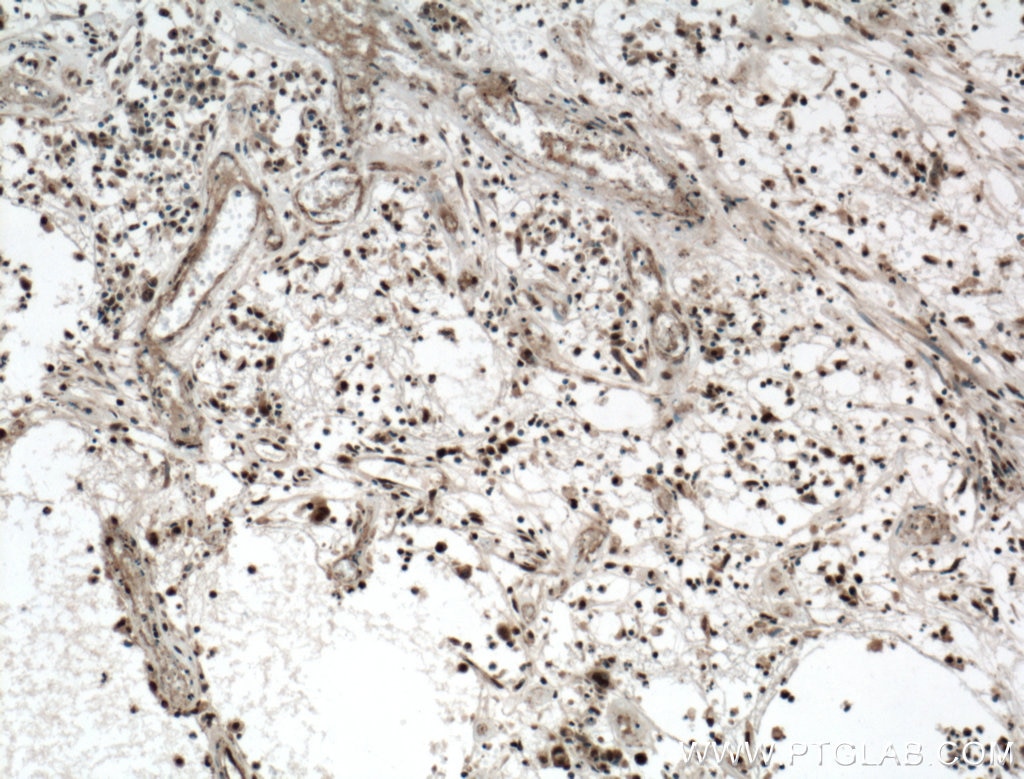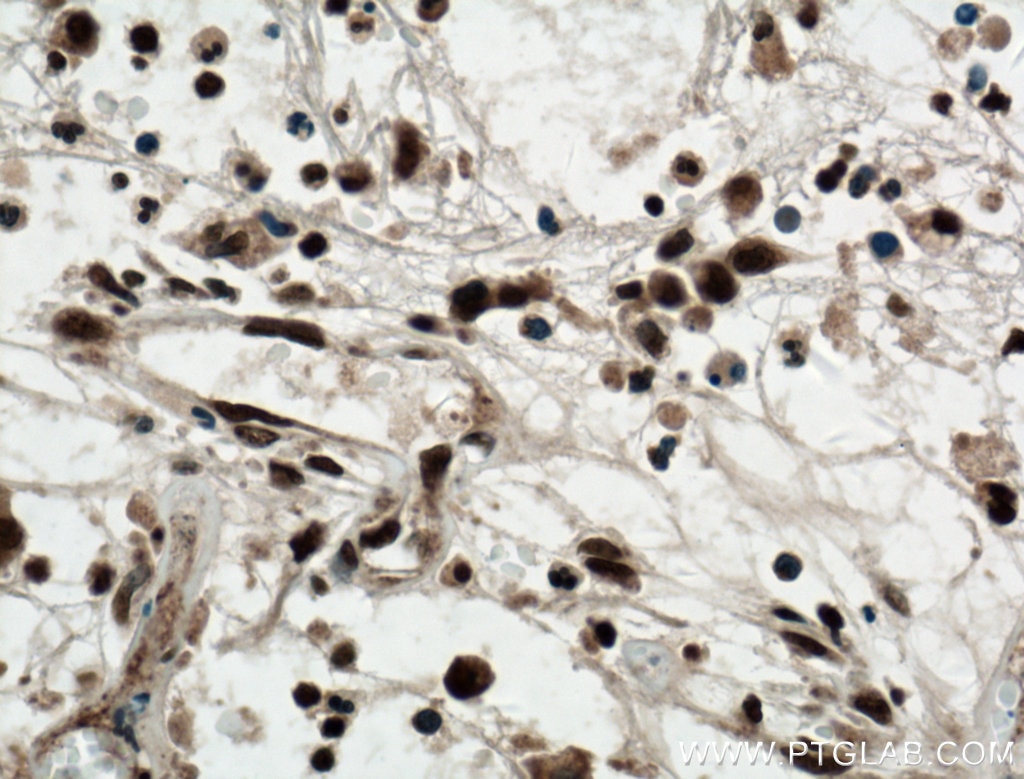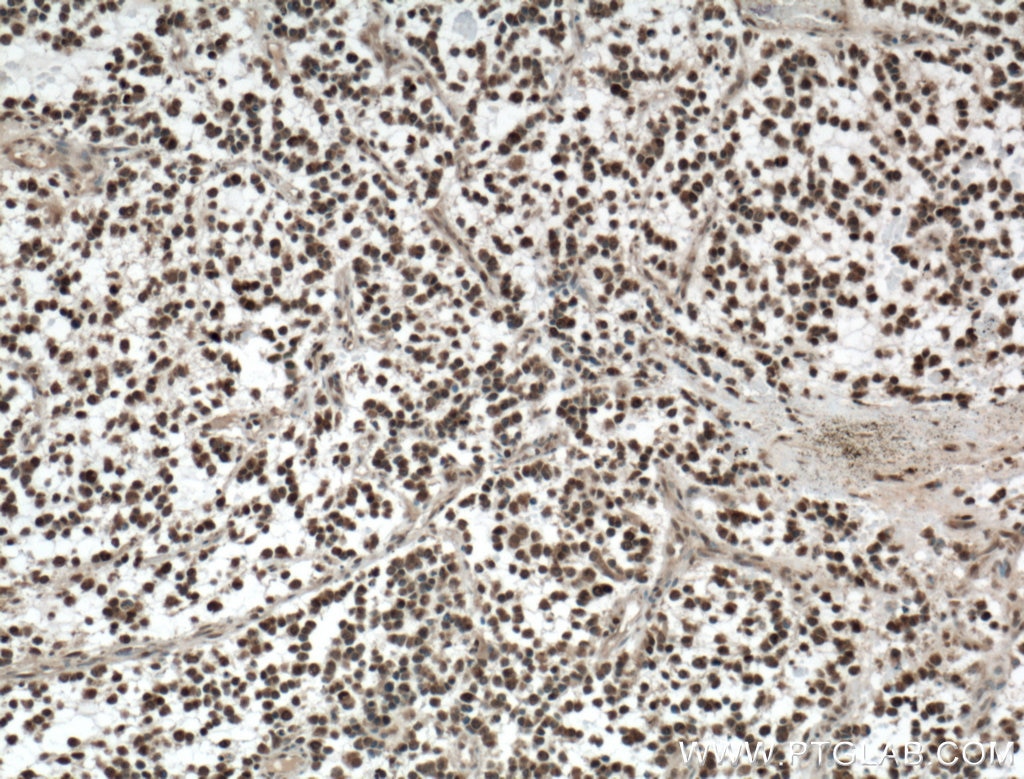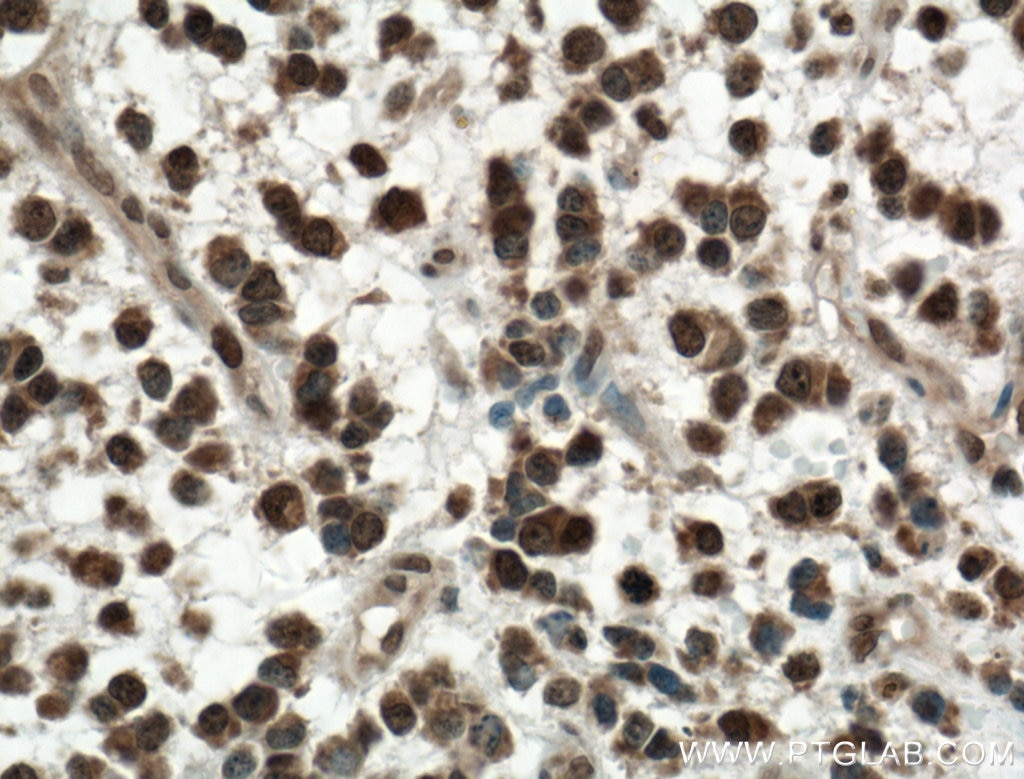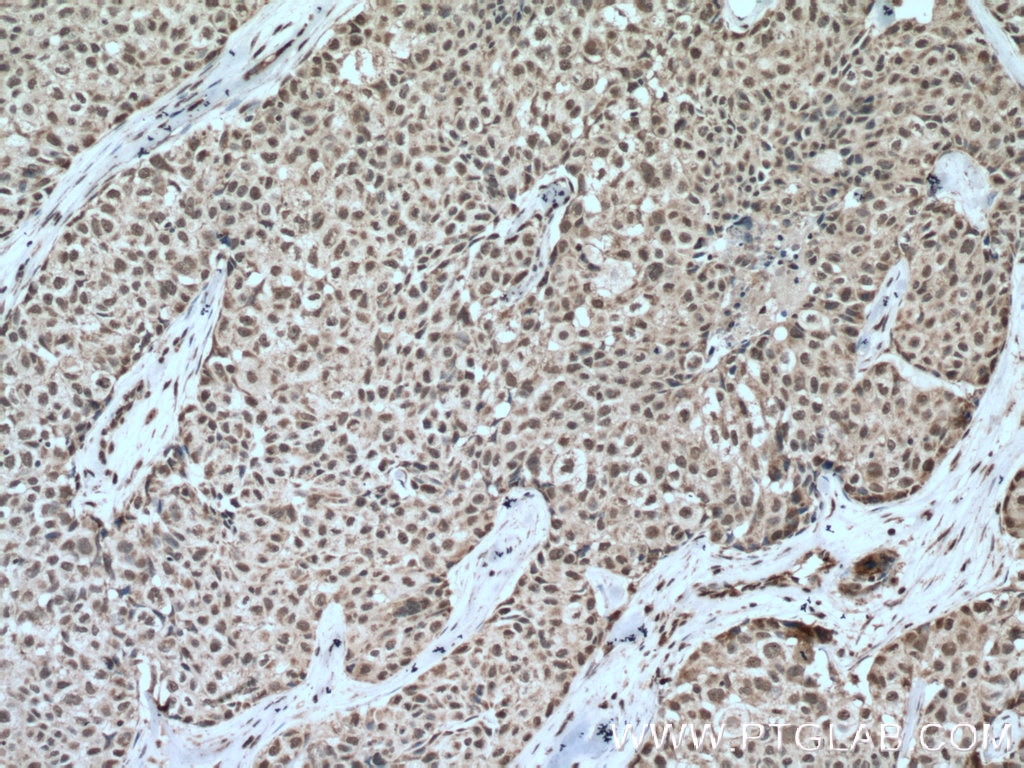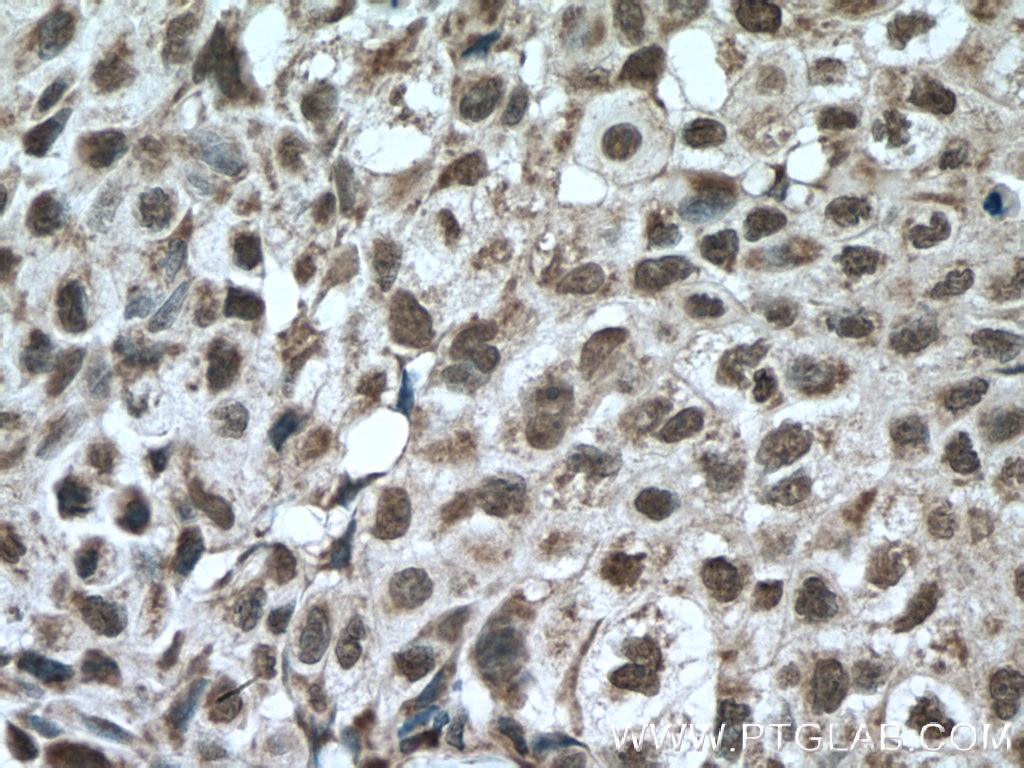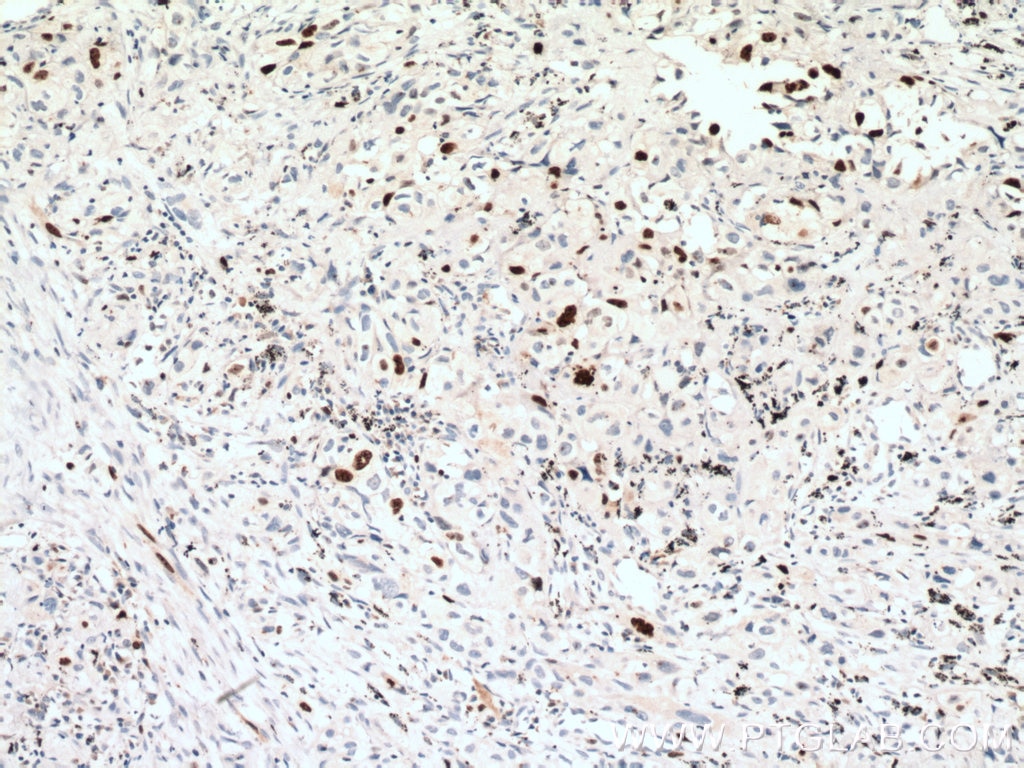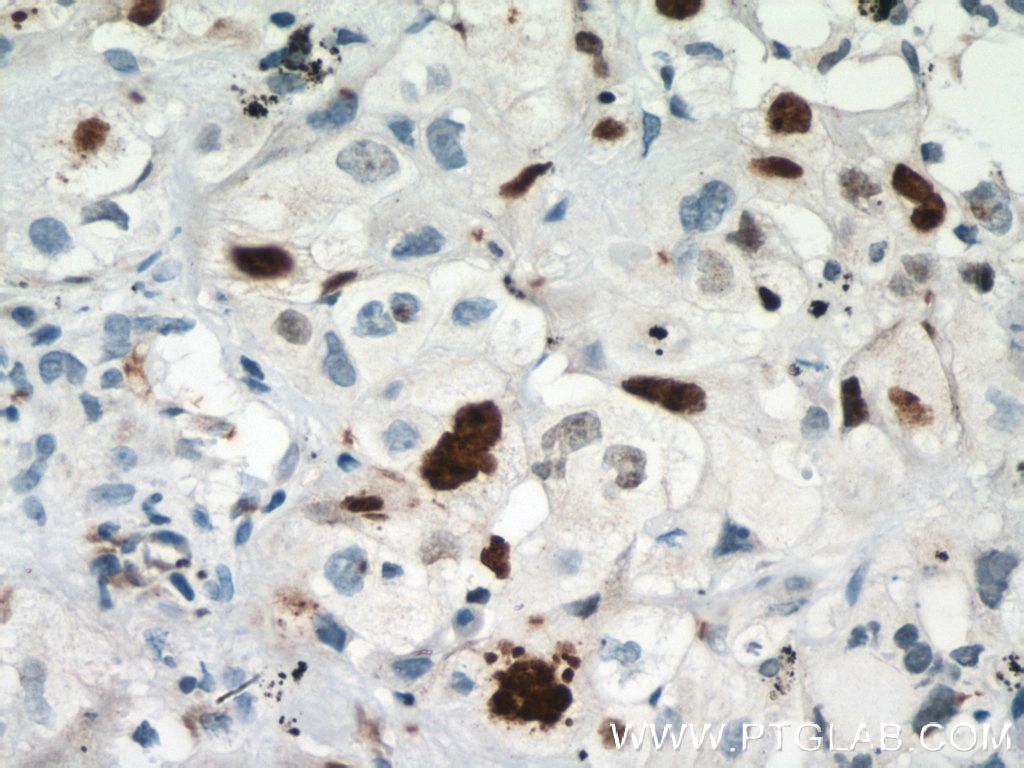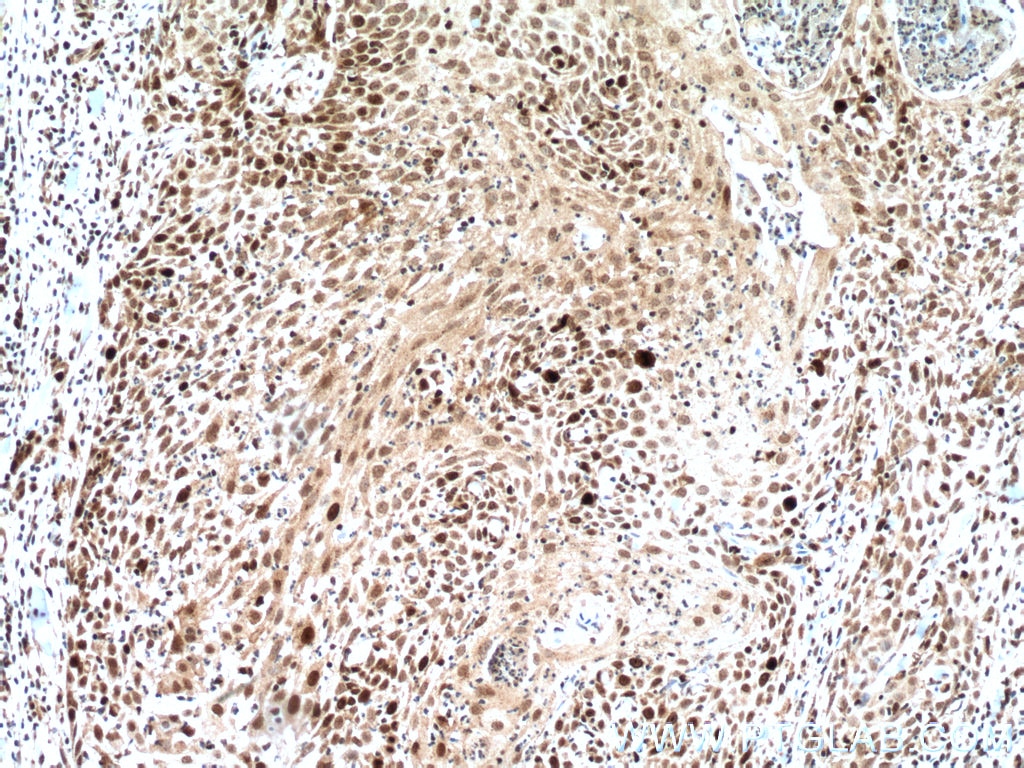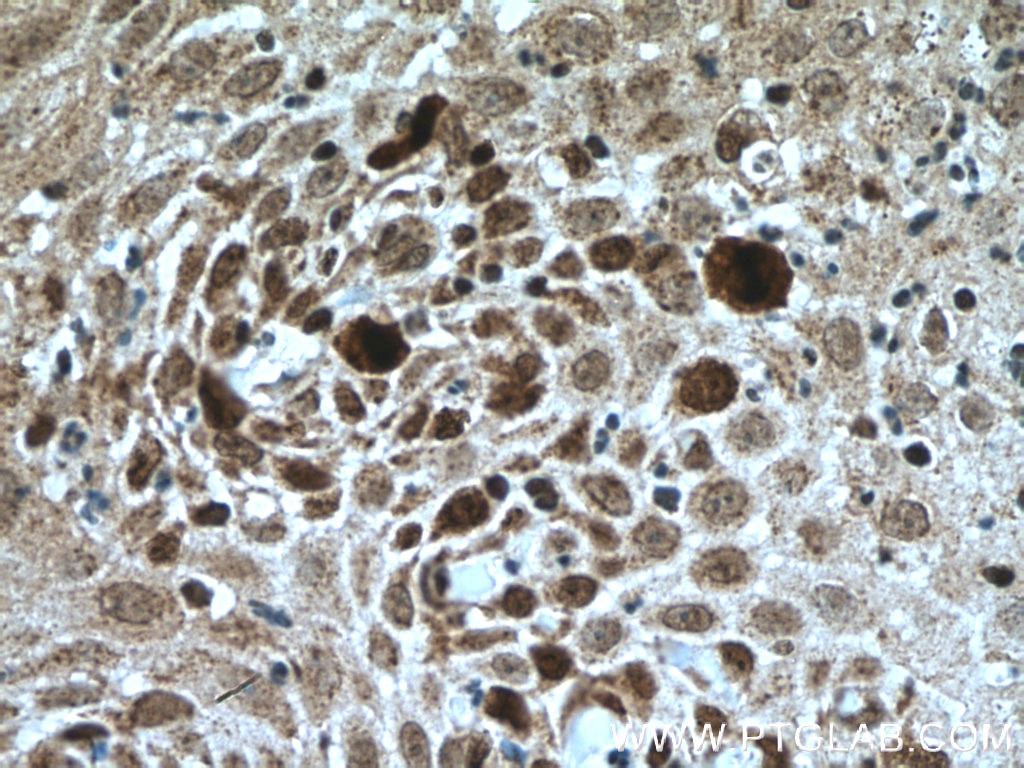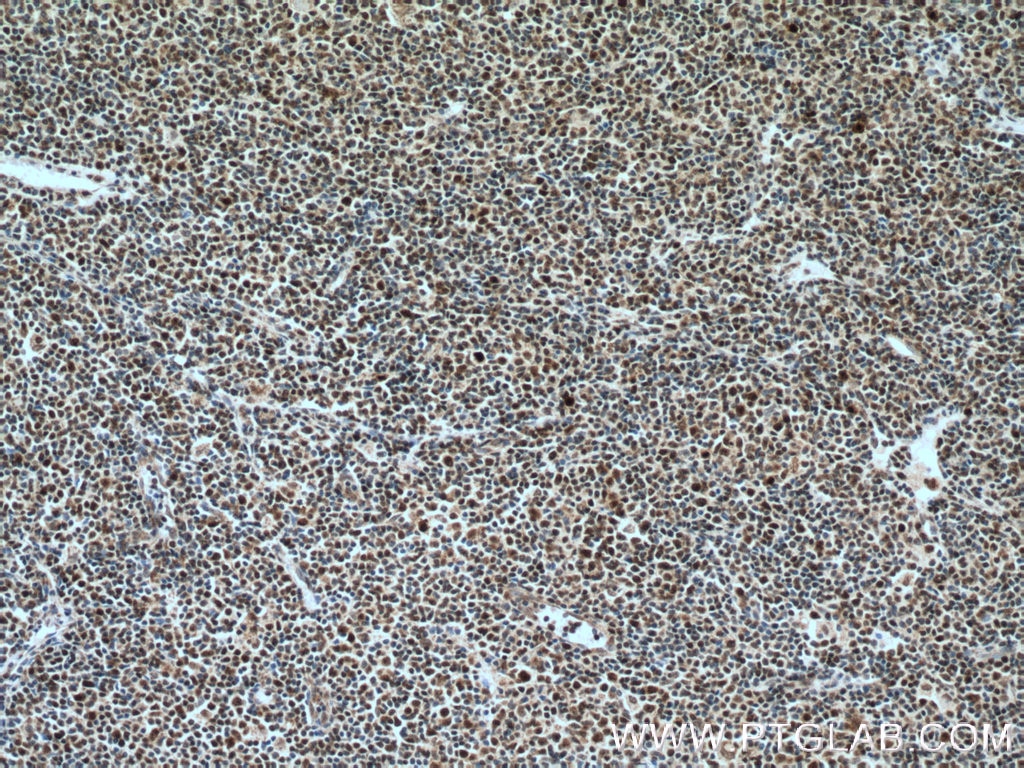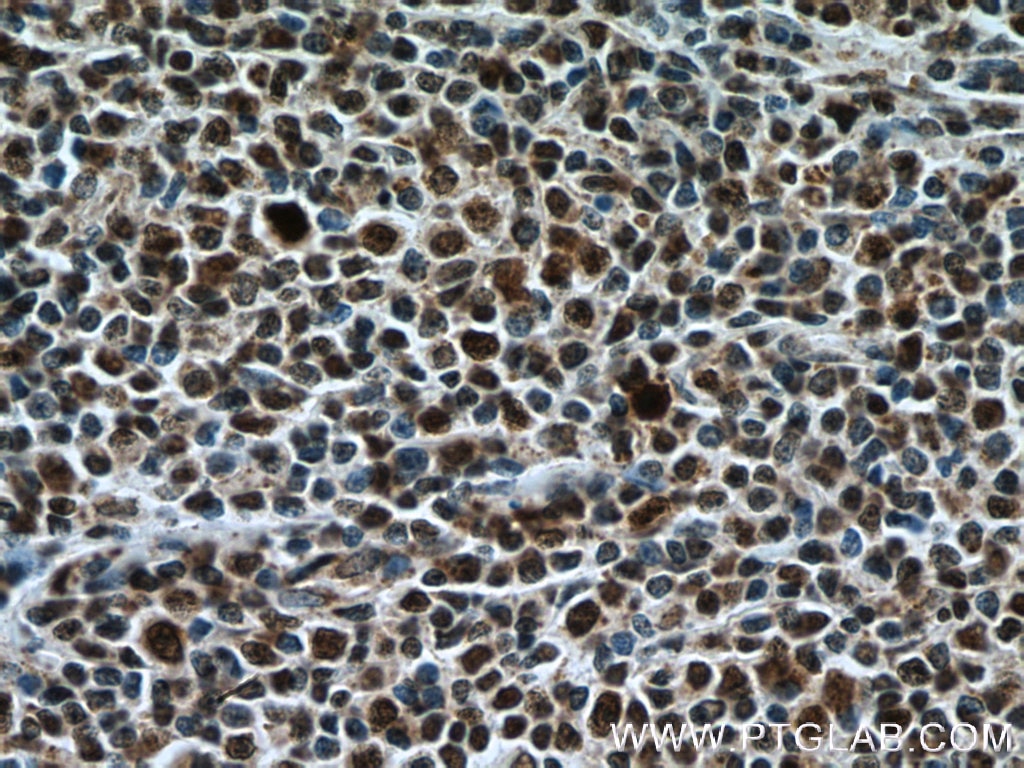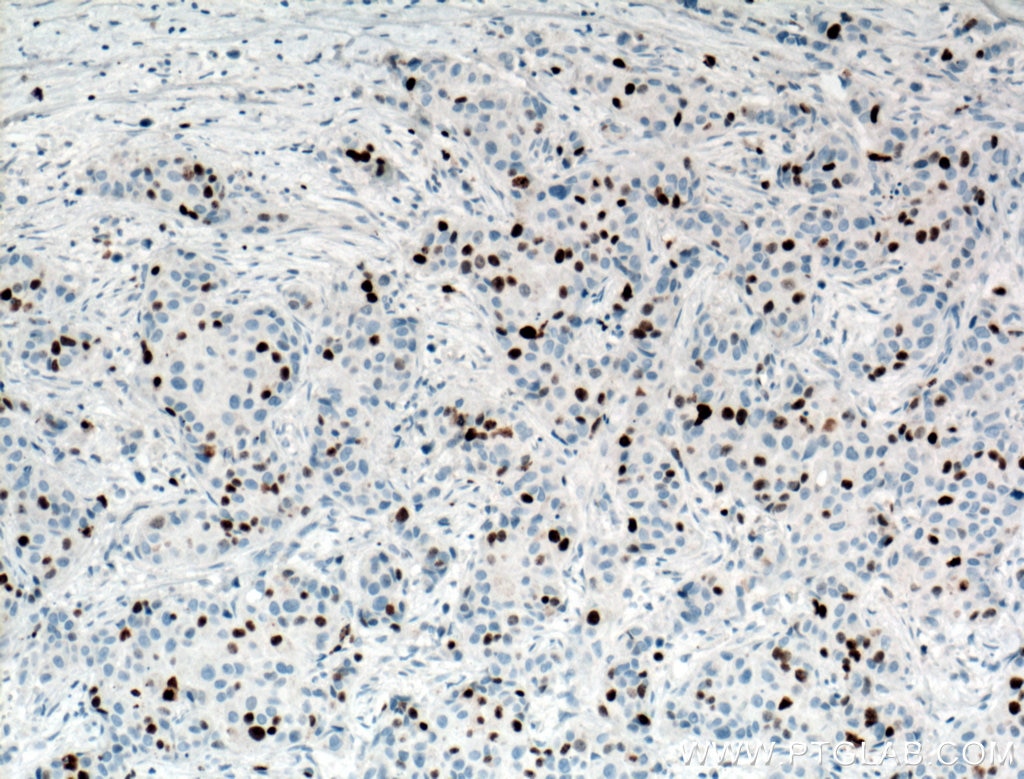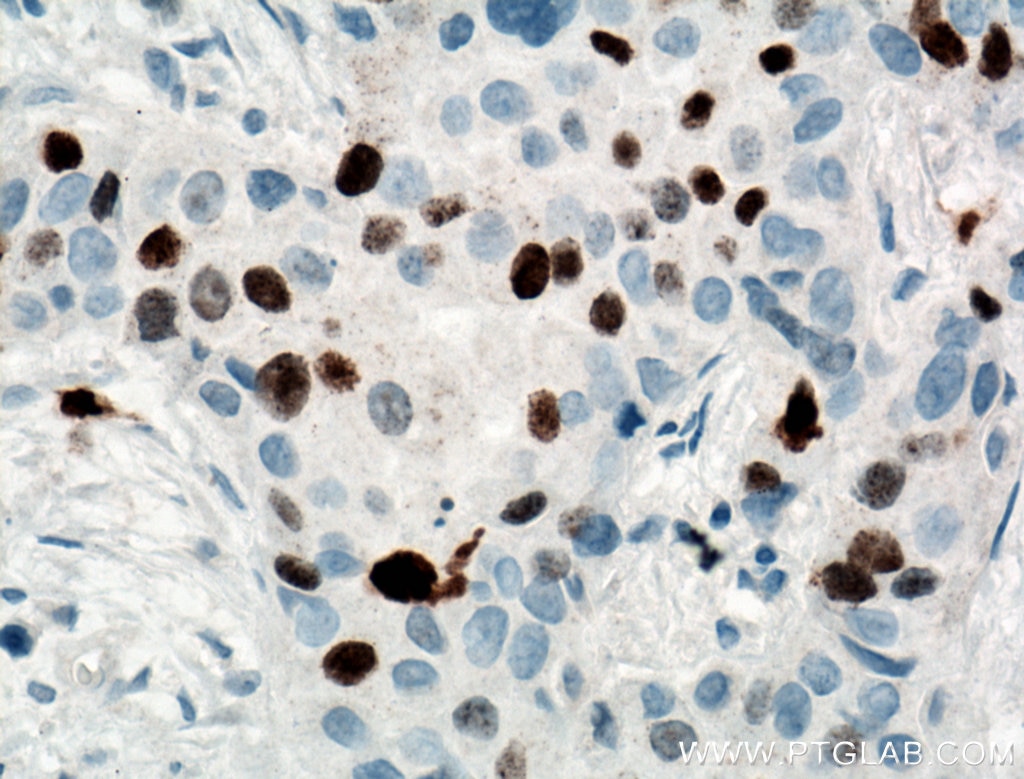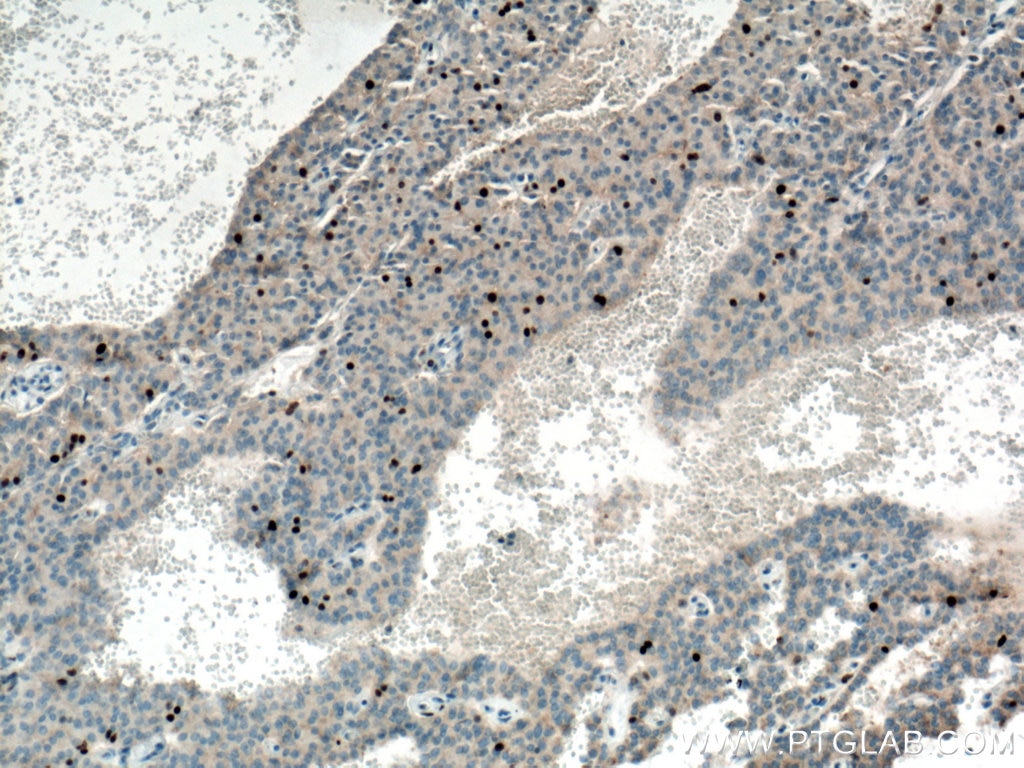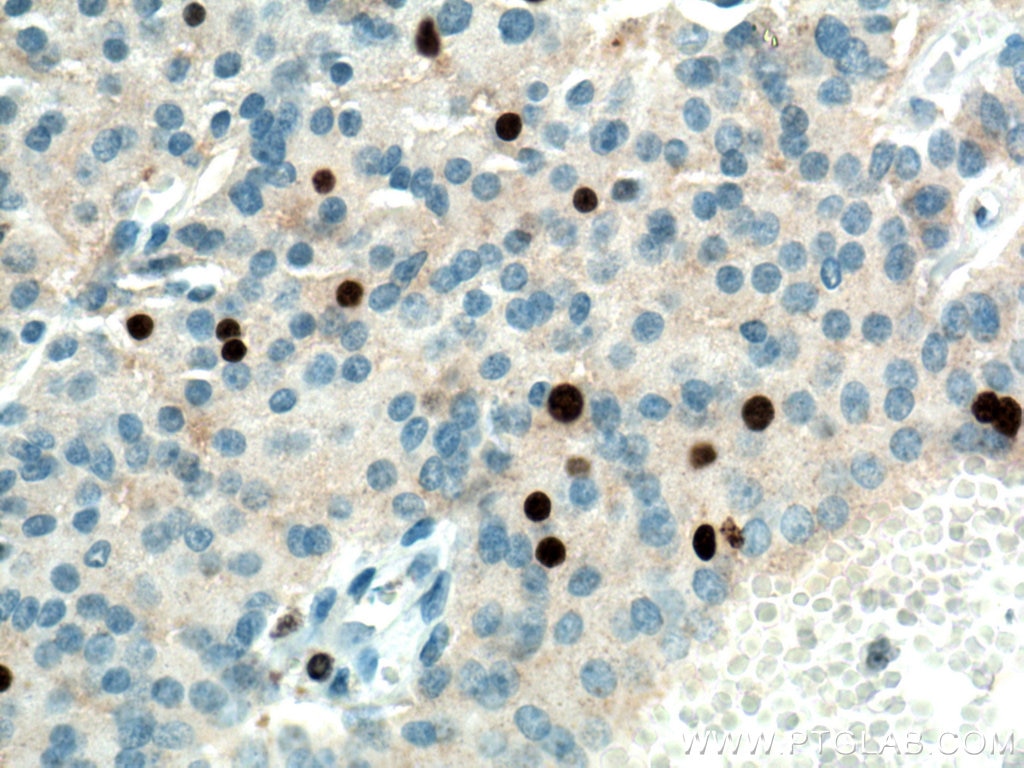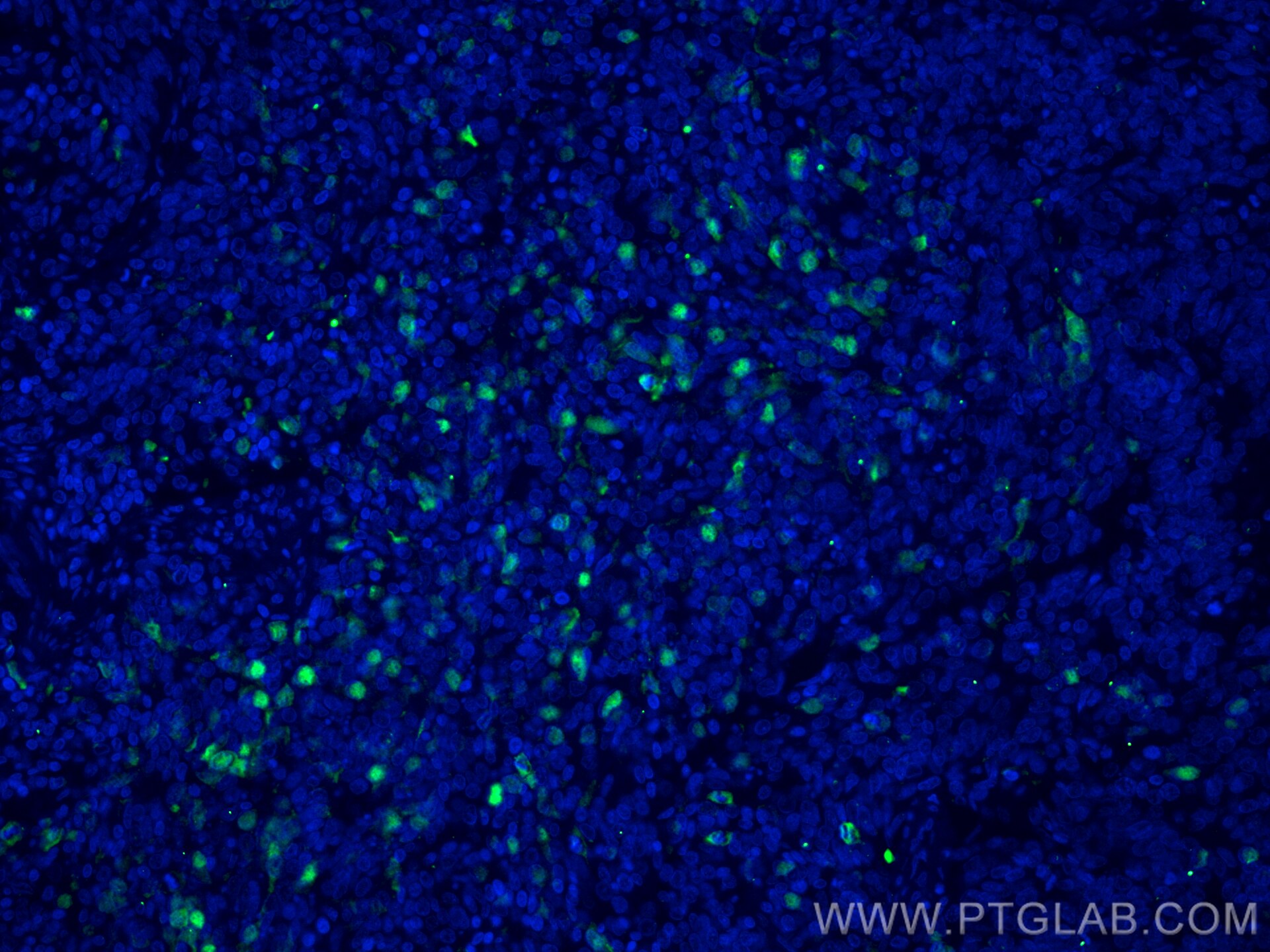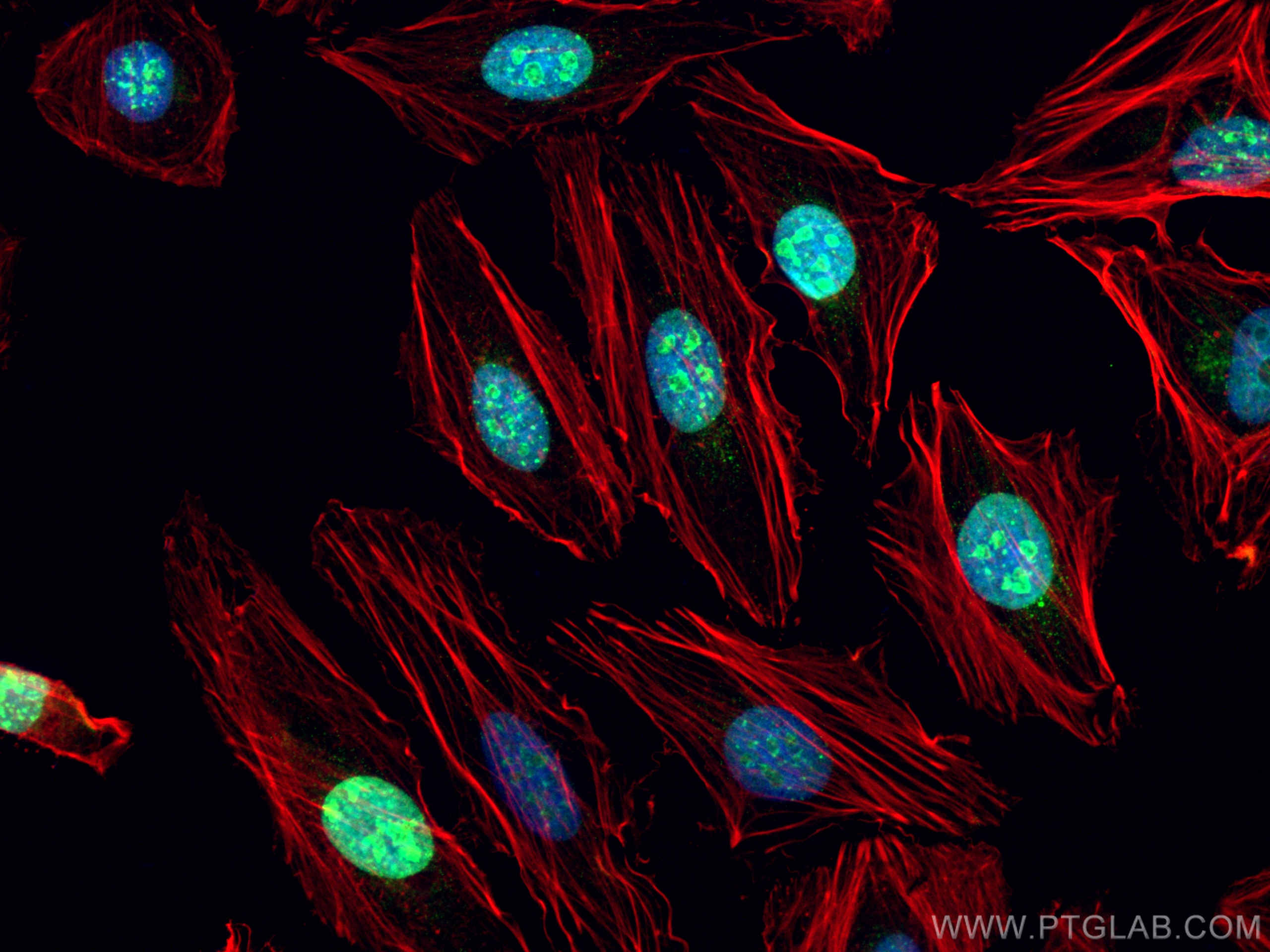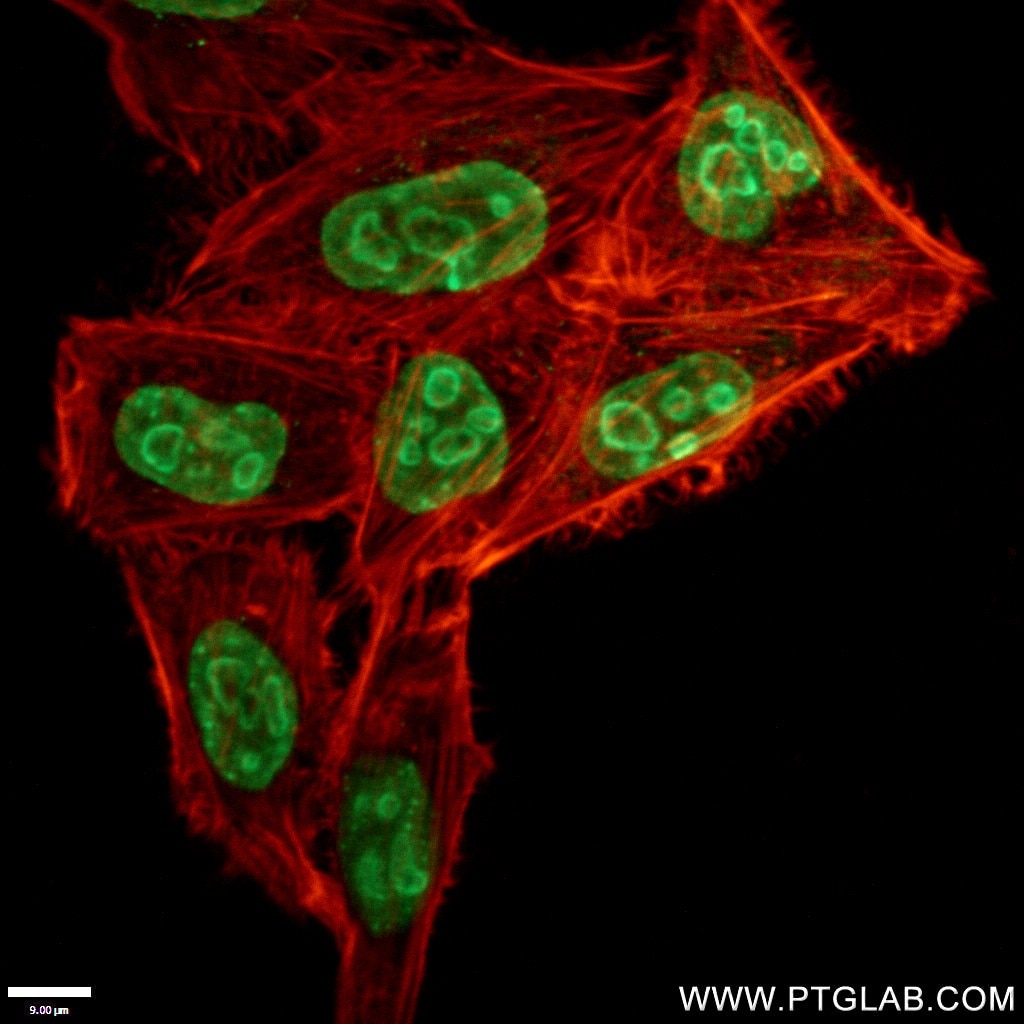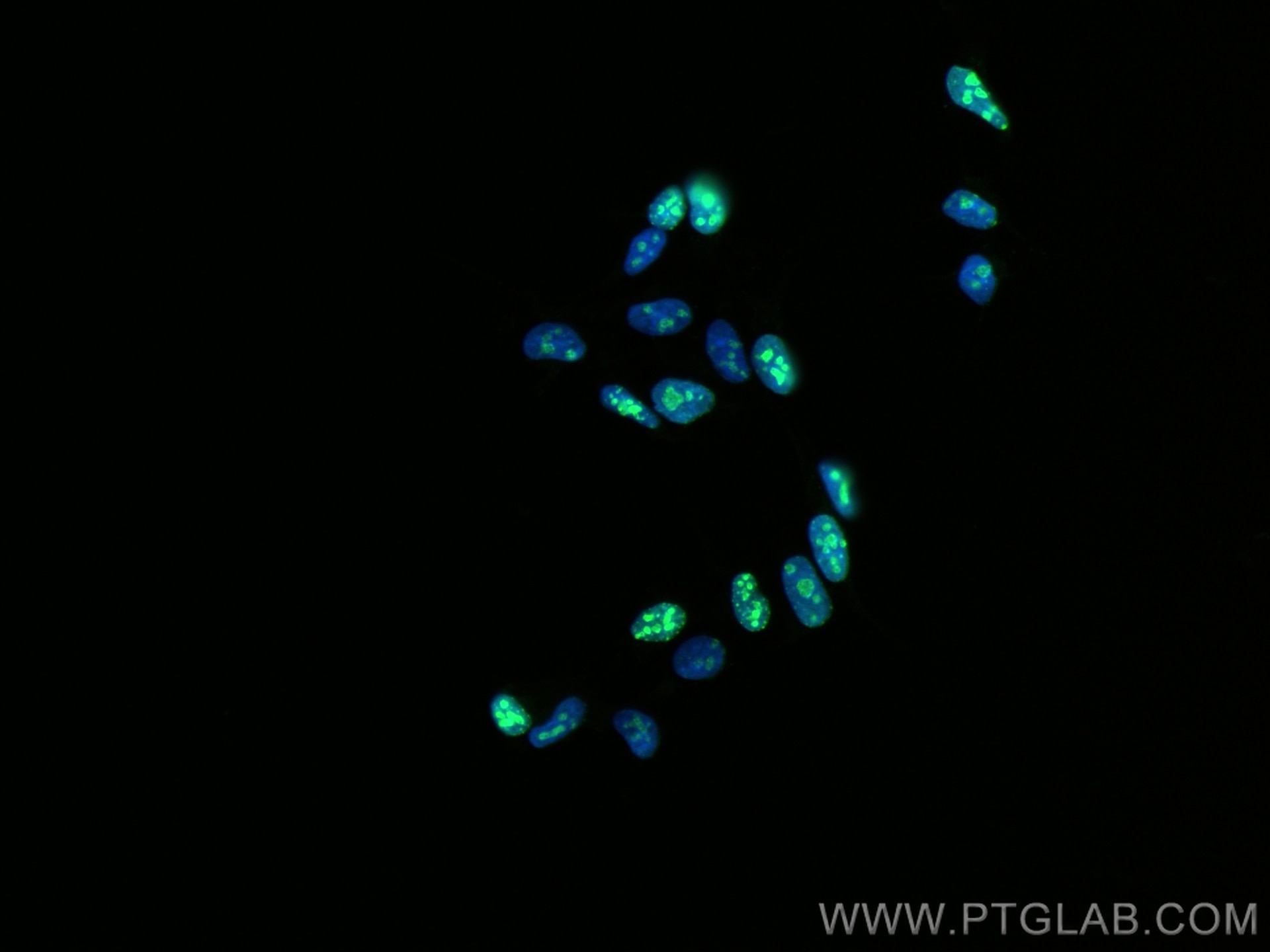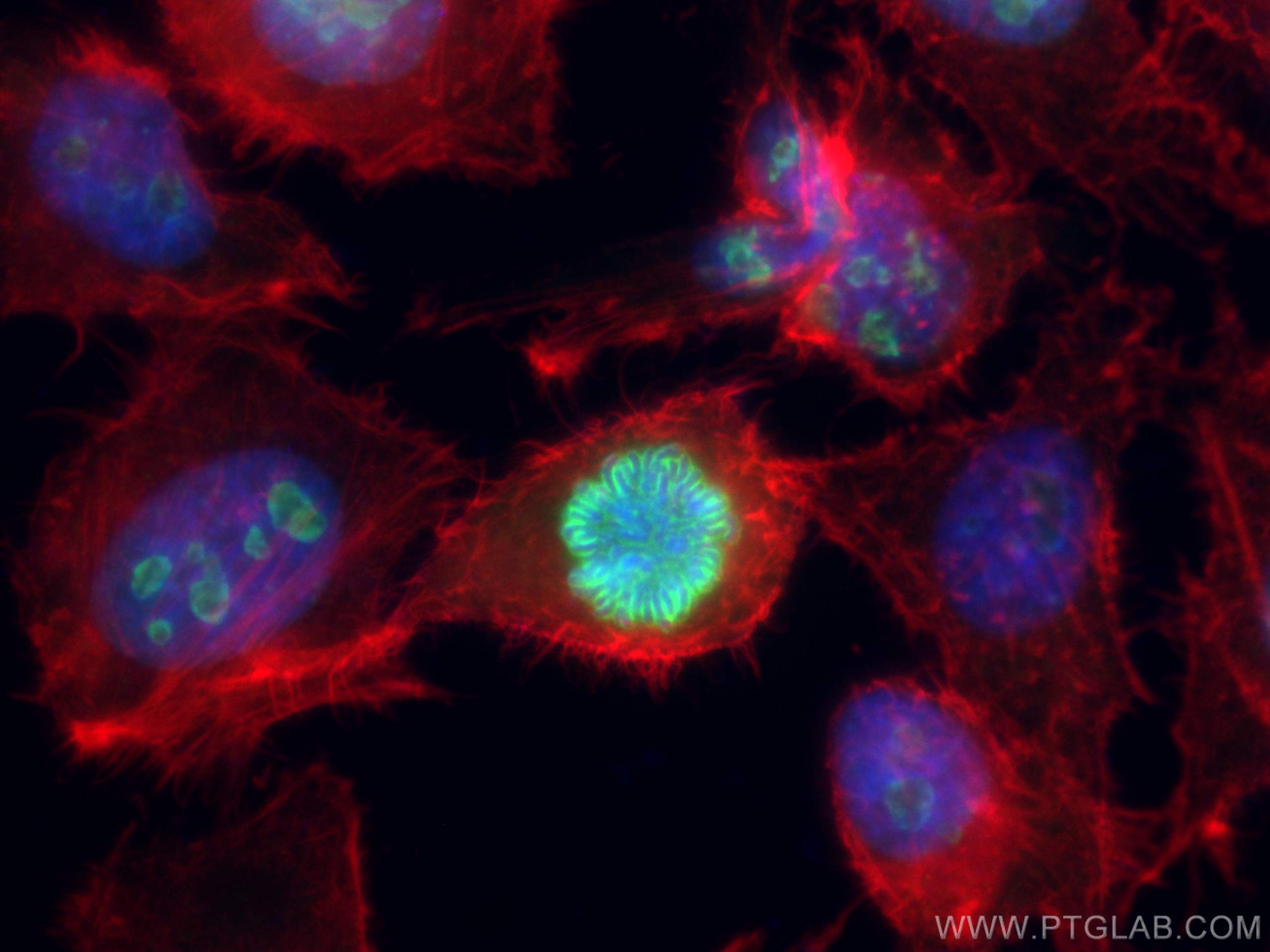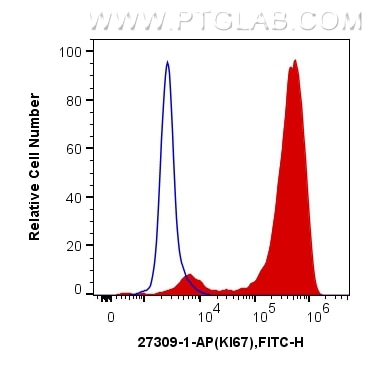- Phare
- Validé par KD/KO
Anticorps Polyclonal de lapin anti-Ki-67
Ki-67 Polyclonal Antibody for IHC, IF/ICC, IF-P, FC (Intra), ELISA
Hôte / Isotype
Lapin / IgG
Réactivité testée
Humain et plus (5)
Applications
IHC, IF/ICC, IF-P, FC (Intra), ELISA
Conjugaison
Non conjugué
N° de cat : 27309-1-AP
Synonymes
Galerie de données de validation
Applications testées
| Résultats positifs en IHC | tissu d'amygdalite humain, cellules K-562, tissu de cancer de la peau humain, tissu de cancer du côlon humain, tissu de cancer du poumon humain, tissu de cancer du sein humain, tissu de gliome humain, tissu de lymphome humain, tissu d'insulinome il est suggéré de démasquer l'antigène avec un tampon de TE buffer pH 9.0; (*) À défaut, 'le démasquage de l'antigène peut être 'effectué avec un tampon citrate pH 6,0. |
| Résultats positifs en IF-P | tissu de cancer du poumon humain, |
| Résultats positifs en IF/ICC | cellules HeLa, cellules HEK-293 |
| Résultats positifs en FC (Intra) | cellules Jurkat |
Dilution recommandée
| Application | Dilution |
|---|---|
| Immunohistochimie (IHC) | IHC : 1:4000-1:16000 |
| Immunofluorescence (IF)-P | IF-P : 1:50-1:500 |
| Immunofluorescence (IF)/ICC | IF/ICC : 1:50-1:500 |
| Flow Cytometry (FC) (INTRA) | FC (INTRA) : 0.40 ug per 10^6 cells in a 100 µl suspension |
| It is recommended that this reagent should be titrated in each testing system to obtain optimal results. | |
| Sample-dependent, check data in validation data gallery | |
Applications publiées
| KD/KO | See 1 publications below |
| IHC | See 998 publications below |
| IF | See 253 publications below |
Informations sur le produit
27309-1-AP cible Ki-67 dans les applications de IHC, IF/ICC, IF-P, FC (Intra), ELISA et montre une réactivité avec des échantillons Humain
| Réactivité | Humain |
| Réactivité citée | canin, Chèvre, Humain, poisson-zèbre, porc, Hamster |
| Hôte / Isotype | Lapin / IgG |
| Clonalité | Polyclonal |
| Type | Anticorps |
| Immunogène | Ki-67 Protéine recombinante Ag26266 |
| Nom complet | antigen identified by monoclonal antibody Ki-67 |
| Masse moléculaire calculée | 359 kDa |
| Numéro d’acquisition GenBank | NM_002417 |
| Symbole du gène | KI67 |
| Identification du gène (NCBI) | 4288 |
| Conjugaison | Non conjugué |
| Forme | Liquide |
| Méthode de purification | Purification par affinité contre l'antigène |
| Tampon de stockage | PBS with 0.02% sodium azide and 50% glycerol |
| Conditions de stockage | Stocker à -20°C. Stable pendant un an après l'expédition. L'aliquotage n'est pas nécessaire pour le stockage à -20oC Les 20ul contiennent 0,1% de BSA. |
Informations générales
The Ki-67 protein (also known as MKI67) is a cellular marker for proliferation. Ki67 is present during all active phases of the cell cycle (G1, S, G2 and M), but is absent in resting cells (G0). Cellular content of Ki-67 protein markedly increases during cell progression through S phase of the cell cycle. Therefore, the nuclear expression of Ki67 can be evaluated to assess tumor proliferation by immunohistochemistry. It has been demonstrated to be of prognostic value in breast cancer. In head and neck cancer, several studies have reported an association between high proliferative activity and poorer prognosis.
Protocole
| Product Specific Protocols | |
|---|---|
| IHC protocol for Ki-67 antibody 27309-1-AP | Download protocol |
| IF protocol for Ki-67 antibody 27309-1-AP | Download protocol |
| Standard Protocols | |
|---|---|
| Click here to view our Standard Protocols |
Publications
| Species | Application | Title |
|---|---|---|
Signal Transduct Target Ther FBXW7β loss-of-function enhances FASN-mediated lipogenesis and promotes colorectal cancer growth | ||
Mol Cancer Cell surface CD55 traffics to the nucleus leading to cisplatin resistance and stemness by inducing PRC2 and H3K27 trimethylation on chromatin in ovarian cancer | ||
Mol Cancer lncRNA ZNRD1-AS1 promotes malignant lung cell proliferation, migration, and angiogenesis via the miR-942/TNS1 axis and is positively regulated by the m6A reader YTHDC2 | ||
Cancer Discov Stress Granules determine the Development of Obesity-associated Pancreatic Cancer. | ||
Adv Mater Supramolecular Hydrogel with Ultra-Rapid Cell-Mediated Network Adaptation for Enhancing Cellular Metabolic Energetics and Tissue Regeneration | ||
Protein Cell NDFIP1 limits cellular TAZ accumulation via exosomal sorting to inhibit NSCLC proliferation |
Avis
The reviews below have been submitted by verified Proteintech customers who received an incentive for providing their feedback.
FH Udesh (Verified Customer) (08-12-2025) | Worked well in Western, also detected a non specific band at 70 kDa
|
FH Celine (Verified Customer) (07-09-2025) | Works well in immunoflurescence with fixed cells
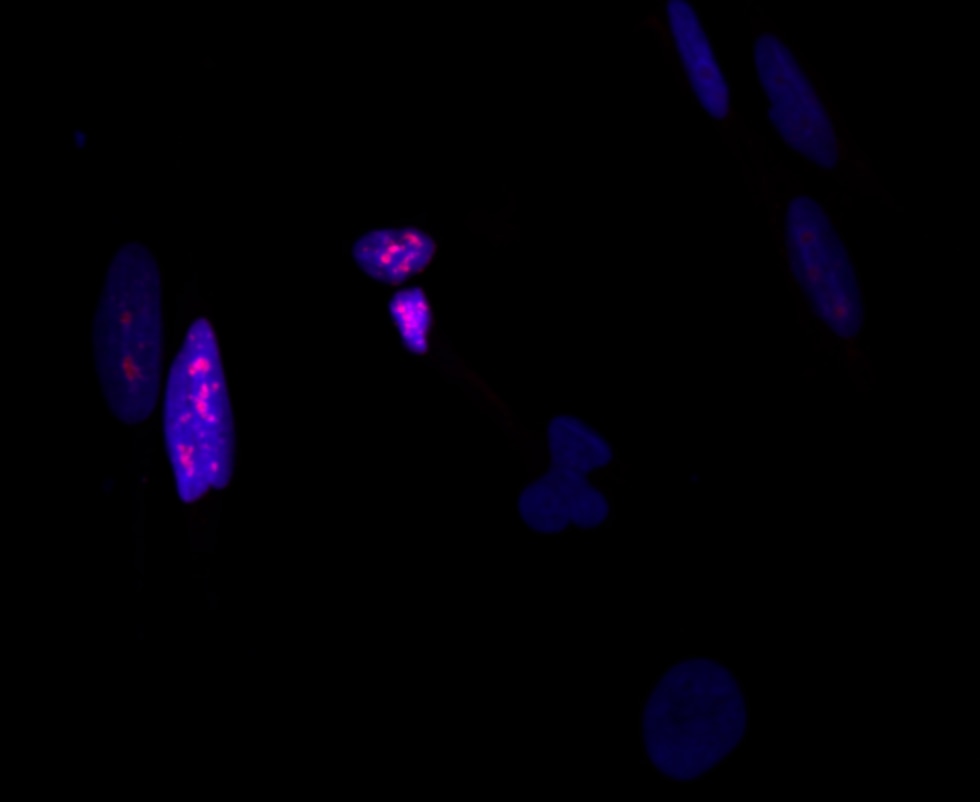 |
FH Guo-rong (Verified Customer) (08-30-2022) | Clear staining
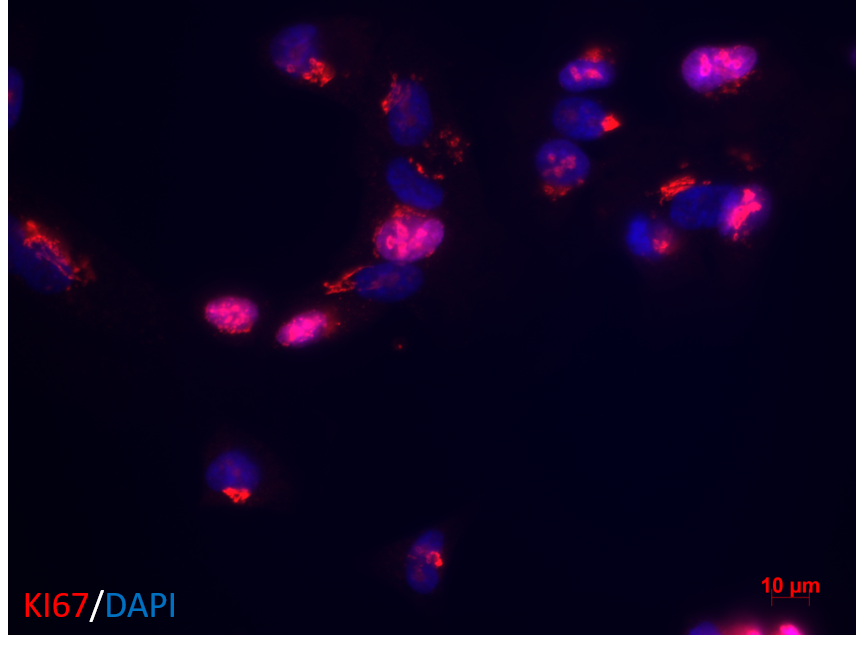 |
FH Alessandro (Verified Customer) (07-27-2022) | No aspecific staining, great outcome
|
FH Ana (Verified Customer) (02-15-2022) | Both, 1:50 and 1:100 dilutions worked well
|
FH kes (Verified Customer) (01-17-2022) | Works at 1:200 dilution for IHC
|
FH Yan (Verified Customer) (02-18-2020) | 1:100 work for cell.
|
